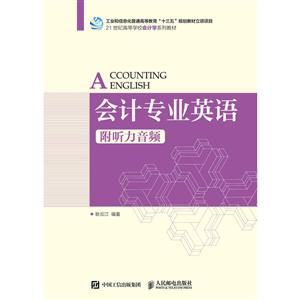会计专业英语(附听力音频)
本书特色
[
本书注重知识体系的完整,突出会计英语实践能力和应用技能的培养,并注重教学内容和教材结构的创新。由于本书具有知识系统、内容翔实、案例丰富、贴近实际、突出实用性、通俗易懂、便于学习等特点,
]
内容简介
[
内 容 提 要
本书以提高英语的应用能力为导向,对财务会计的基本知识做了详细介绍,同时涉及成本会计、管理会计、审计等内容。全书共10章,主要内容包括会计概述、会计循环、财务报表、流动资产、非流动资产、负债、所有者权益、收入、费用、成本会计等。同时,每章还配有学习目标、听力音频、知识拓展、关键术语、复习讨论题、练习题、参考译文等。
本书不仅可以作为高等院校会计学、财务管理、审计等专业的教材,也可以作为财务会计人员、管理人员的自学用书。
]
作者简介
[
耿云江 2002年4月至今任教东北财经大学会计学院,主要讲授管理会计、Financial Statement Analysis,会计英语等。参编高级财务管理、管理会计、公司理财等教材多部。
]
目录
Chapter 1 Overview of Accounting 1Listening Online 1Learning Objectives 11.1 Accounting and Accounting Profession 11.1.1 Ethics 21.1.2 Accounting Function 21.1.3 Accounting Information Users 31.1.4 Accounting Profession 31.2 Accounting Assumptions 41.2.1 Business Entity 41.2.2 Going-concern 51.2.3 Monetary Unit 61.2.4 Time Period 71.3 Accounting Principles 81.3.1 Accrual Basis 81.3.2 Historical Cost 91.3.3 Realization 101.3.4 Matching 111.3.5 Full Disclosure 111.4 Quality Characteristics of Accounting Information 111.4.1 Relevance 131.4.2 Reliability 131.4.3 Comparability 141.4.4 Materiality 14Key Terminologies 15Review and Discussion Questions 17Exercises 17参考译文 18Chapter 2 Accounting Cycle 26Listening Online 26Learning Objectives 262.1 Accounting Equation andDouble-entry System 262.1.1 Accounting Equation 262.1.2 Double-entry System 272.2 Accounting Cycle 272.3 Journals 282.4 Ledgers 292.5 Adjusting 302.5.1 Prepaid Expenses 302.5.2 Accrued Expenses 312.5.3 Accrued Revenues 322.5.4 Unearned Revenues 322.6 Closing Process 332.6.1 Temporary and Permanent Accounts 332.6.2 Posting Closing Entries 332.7 Trial Balance 342.7.1 Steps in Preparing a Trial Balance 342.7.2 Searching For and Correcting Errors 35Key Terminologies 36Review and Discussion Questions 37Exercises 37参考译文 38Chapter 3 Financial Statements 45Listening Online 45Learning Objectives 453.1 Balance Sheet 453.1.1 Components of Balance Sheet 453.1.2 Form of Balance Sheet 473.2 Income Statement 503.2.1 Components of Income Statement 503.2.2 Form of Income Statement 523.3 Cash Flow Statement 543.3.1 Components of Cash Flow Statement 543.3.2 Preparation of Cash Flow Statement 553.4 Statement of Changes in Equity 583.4.1 Components of Statement of Changes in Equity 593.4.2 Preparation of Statement of Changes in Equity 593.5 Notes to Financial Statements 613.5.1 Accounting Policy 613.5.2 Financial Instruments 613.5.3 Related Party Transactions 623.5.4 Contingencies 623.5.5 Subsequent Events 62Key Terminologies 65Review and Discussion Questions 66Exercises 67参考译文 68Chapter 4 Current Assets 81Listening Online 81Learning Objectives 814.1 Monetary Capital 814.1.1 Cash 814.1.2 Management of Cash-bank Reconciliation 824.1.3 Internal Control Over Cash 834.1.4 Petty Cash Fund 844.1.5 Cash Over and Short 844.2 Receivables 854.2.1 Classification of Receivables 854.2.2 Bad Debts 854.2.3 Estimation of Bad Debts 874.3 Inventories 884.3.1 Inventory System 884.3.2 Cost of Inventory Acquired 894.3.3 Ending Inventory Valuation 89Key Terminologies 91Review and Discussion Questions 92Exercises 92参考译文 93Chapter 5 Non-currentAssets 100Listening Online 100Learning Objectives 1005.1 Fixed Assets 1005.1.1 Definition and Characteristics of Fixed Assets 1005.1.2 Classification of Fixed Assets 1015.1.3 Costs of Fixed Assets 1015.1.4 Post-acquisition Expenditures 1025.1.5 Depreciation and Impairment 1035.1.6 Disposals of Fixed Assets 1045.2 Intangible Assets 1055.2.1 Definition and Characteristics of Intangible Assets 1055.2.2 Main Categories of Intangible Assets 1055.2.3 Recognition and Measurement of Intangible Assets 1065.2.4 Post-acquisition Measurement 1075.2.5 Disposals of Intangible Assets 1085.3 Investments 1085.3.1 Objectives of Investment 1085.3.2 Types of Securities 109Key Terminologies 110Review and Discussion Questions 111Exercises 111参考译文 113Chapter 6 Liabilities and Owner’sEquity 119Listening Online 119Learning Objectives 1196.1 Current Liabilities 1196.1.1 Definition of Current Liabilities 1196.1.2 Accounts Payable 1206.1.3 Short-term Notes Payable 1206.1.4 Unearned Revenue 1206.1.5 Short-term Borrowings 1206.1.6 Accrued Liabilities 1216.1.7 Dividend Payable 1216.1.8 Current Portion of Long-term Obligation 1216.2 Non-current Liabilities 1226.2.1 Long-term Borrowings 1236.2.2 Bonds Payable 1236.2.3 Long-term Notes Payable 1246.2.4 Pension Plans 1246.3 Types of Organization 1256.3.1 Sole Proprietorship 1256.3.2 Partnership 1256.3.3 Corporation 1266.4 Owner’s Equity 1276.4.1 Rights of Stockholders 1276.4.2 Retained Earnings 1286.4.3 Dividend 128Key Terminologies 129Review and Discussion Questions 130Exercises 130参考译文 131Chapter 7 Revenue andExpense 138Listening Online 138Learning Objectives 1387.1 Revenue 1387.1.1 Definition of Revenue 1387.1.2 The Earning Process of Revenue 1397.1.3 Recognition of Revenue 1397.2 Expense 1417.2.1 Definition of Expense 1417.2.2 Cost Vs Expense 1427.2.3 Recognition of Expense 1427.2.4 Specific Expense Items 142Key Terminologies 144Review and Discussion Questions 144Exercises 144参考译文 146Chapter 8 Cost Accounting 150Listening Online 150Learning Objectives 1508.1 Overview of Cost Accounting 1508.1.1 Definition of CostAccounting 1508.1.2 Features of Cost Accounting 1508.1.3 Financial Accounting, Management Accounting andCost Accounting 1518.1.4 Cost Classifications 1528.2 Costing Method 1558.2.1 Job-order Costing 1558.2.2 Process Costing 1568.2.3 Activity Based Costing 158Key Terminologies 160Review and Discussion Questions 161Exercises 161参考译文 162Chapter 9 Management Accounting 168Listening Online 168Learning Objectives 1689.1 Introduction to Management Accounting 1689.1.1 Definition of Management Accounting 1689.1.2 Comparison of Financial and Management Accounting 1689.1.3 Functions of Management Accounting 1709.2 Cost Behavior 1719.2.1 Variable Cost 1719.2.2 Fixed Cost 1729.2.3 Mixed Cost 1729.3 Cost-Volume-Profit Analysis 1739.3.1 Basic Concept of Cost-Volume-Profit Analysis 1739.3.2 Break-even Analysis 1749.3.3 Target Profit Analysis 1759.4 Budget and PerformanceEvaluation 1769.4.1 Budget 1769.4.2 Performance Evaluation 177Key Terminologies 179Review and Discussion Questions 180Exercises 180参考译文 181Chapter 10 Audit 187Listening Online 187Learning Objectives 18710.1 Introduction to Audit 18710.1.1 Definition of Audit 18710.1.2 Types of Audit 18910.1.3 Types of Auditors 19010.1.4 Componets of Audit Report 19110.2 Audit Procedure 19210.2.1 Management Assertions 19210.2.2 Identify Audit Objectives 19310.2.3 Carry Out Audit Specifically 19410.3 Internal Control 19810.3.1 Definition of Internal Control 19810.3.2 Development History of Internal Control 19910.3.3 Elements of Internal Control 199Key Terminologies 202Review and Discussion Questions 203Exercises 203参考译文 204
封面

书名:会计专业英语(附听力音频)
作者:耿云江
页数:0
定价:¥42.0
出版社:人民邮电出版社
出版日期:2017-03-01
ISBN:9787115472472
PDF电子书大小:69MB 高清扫描完整版
